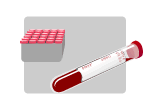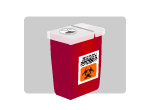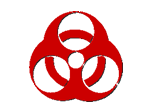
 |
|||
Recommendations for Protecting Laboratory, Field, and Clinical Workers From West Nile Virus Exposure
IntroductionDisease:
|
 |
 |
 |
 |
The most likely way persons become infected with WNV is through the bite of an infected mosquito. Therefore, persons working outdoors when mosquitoes are actively biting are at risk of infection (link to NIOSH Fact Sheet: Recommendations to Prevent West Nile Virus Infection in Outdoor Workers). Aside from outdoor workers, workers in many other occupations are at potential risk of exposure to WNV-infected humans, animals, or their blood or other tissues. Workers at risk include laboratory diagnosticians, researchers, and technicians, veterinarians and their staff, wildlife rehabilitators, ornithologists, wildlife biologists, pathologists, zoo and aviary curators, health care workers, emergency response and public safety personnel, public health employees, and workers in related occupations. For example, workers are at risk of WNV infection if their skin is penetrated or cut while performing necropsies or handling WNV-infected tissues or fluids. Turkey breeder and alligator farm workers have been infected with WNV. The mode of transmission to these farm workers is uncertain.
 |
 |
 |
The following recommendations are for both the laboratory and field workplaces in which transmission of WNV may occur by means other than mosquito bite. Until further studies determine the risk of WNV infection from exposure to infected persons, animals, fluids, or tissues, it is prudent public health practice to minimize such potentially infectious contacts. These are basic recommendations to reduce exposure to blood and other tissues from WNV-infected cases. More stringent protective equipment and work practices should be used when warranted. Biosafety guidelines are available for working with WNV and other microbiological agents in the laboratory.
Recommendations for employers
|
Recommendations for workers
|
For more information on biosafety, link to "Biosafety in the
Laboratory", a CDC Office of Health and Safety presentation:
http://www.cdc.gov/od/ohs/pdffiles/Module%202%20-%20Biosafety.pdf
![]()
Anyone handling dead animals should wear gloves. Appropriate gloves provide a protective barrier that prevents blood and other body fluids from passing through them. Medical examination gloves are recommended. Cotton, leather, and other absorbent glove materials are not protective. If latex gloves are used they should be reduced protein, powder-free gloves to reduce workers’ exposure to allergy-causing proteins.
Any laboratory incidents or accidents involving possible WNV exposure should be immediately reported to the supervisor. Any worker who has health concerns should contact his or her health care provider.
Mild symptoms of WNV infection include fever, fatigue, headache, and muscle or joint pain. Severe symptoms include high fever, stiff neck, disorientation, tremors, muscle weakness, and paralysis. The incubation time from mosquito bite to clinical symptoms is reported to be from 3 to 14 days. No specific treatment exists for WNV infection. Treatment consists of supportive care for the individual. Currently, no approved vaccine exists to prevent WNV infection in humans.
CDC [2002a]. Possible West Nile Virus Transmission to an Infant Through
Breast-Feeding — Michigan, 2002. MMWR 51(39): 877-878.
http://www.cdc.gov/mmwr/preview/mmwrhtml/mm5139a2.htm
![]()
CDC [2002b]. Update: Investigations of West Nile Virus Infections
in Recipients of Organ Transplantation and Blood Transfusion —
Michigan, 2002. MMWR 51(39): 879.
http://www.cdc.gov/mmwr/PDF/wk/mm5139.pdf
![]()
CDC [2002c]. Intrauterine West Nile Virus Infection — New York,
2002. MMWR 51(50): 1135-36. http://www.cdc.gov/mmwr/preview/mmwrhtml/mm5150a3.htm
CDC [2002d]. Laboratory-Acquired West Nile Virus Infections — United
States, 2002. MMWR 51(50): 1133-1135.
http://www.cdc.gov/mmwr/preview/mmwrhtml/mm5150a2.htm
CDC [2003]. West Nile Virus Infection Among Turkey Breeder Farm Workers
--- Wisconsin, 2002. MMWR 52(42): 1017-1019.
http://www.cdc.gov/mmwr/preview/mmwrhtml/mm5242a3.htm
CDC/NIH [1999]. Biosafety in Microbiological and Biomedical Laboratories,
4th edition. Washington, DC: U.S. Department of Health and Human Services,
Public Health Service, Centers for Disease Control and Prevention
and National Institutes of Health, DHHS Publication No. 99-xxxx.
http://www.cdc.gov/od/ohs/biosfty/bmbl4/bmbl4toc.htm
NIOSH [1997]. NIOSH Alert: Preventing Allergic Reactions to Natural
Rubber Latex in the Workplace. Cincinnati, OH: U.S. Department of
Health and Human Services, Public Health Service, Centers for Disease
Control and Prevention, NIOSH, DHHS Publication No. 97-135.
http://www.cdc.gov/niosh/latexalt.html
NIOSH [1999]. NIOSH Alert: Preventing Needlestick Injuries. Cincinnati,
OH: U.S. Department of Health and Human Services, Public Health Service,
Centers for Disease Control and Prevention, NIOSH, DHHS Publication
No. 2000-108.
http://www.cdc.gov/niosh/2000-108.html
Reviewed August 22, 2005
Safer - Healthier - People |
For additional information, contact NIOSH: 1-800-35-NIOSH (1-800-356-4674) Fax: 513-533-8573 or visit the NIOSH Web site: www.cdc.gov/niosh |
|
|